Key takeaways:
- Common Table Expressions (CTEs) enhance SQL query readability and maintainability, transforming complex queries into manageable sections.
- CTEs come in two types: non-recursive (for straightforward queries) and recursive (for hierarchical data analysis), each serving distinct purposes.
- Best practices for using CTEs include maintaining clarity through meaningful names, breaking down complex logic, and limiting the data scope for improved performance.
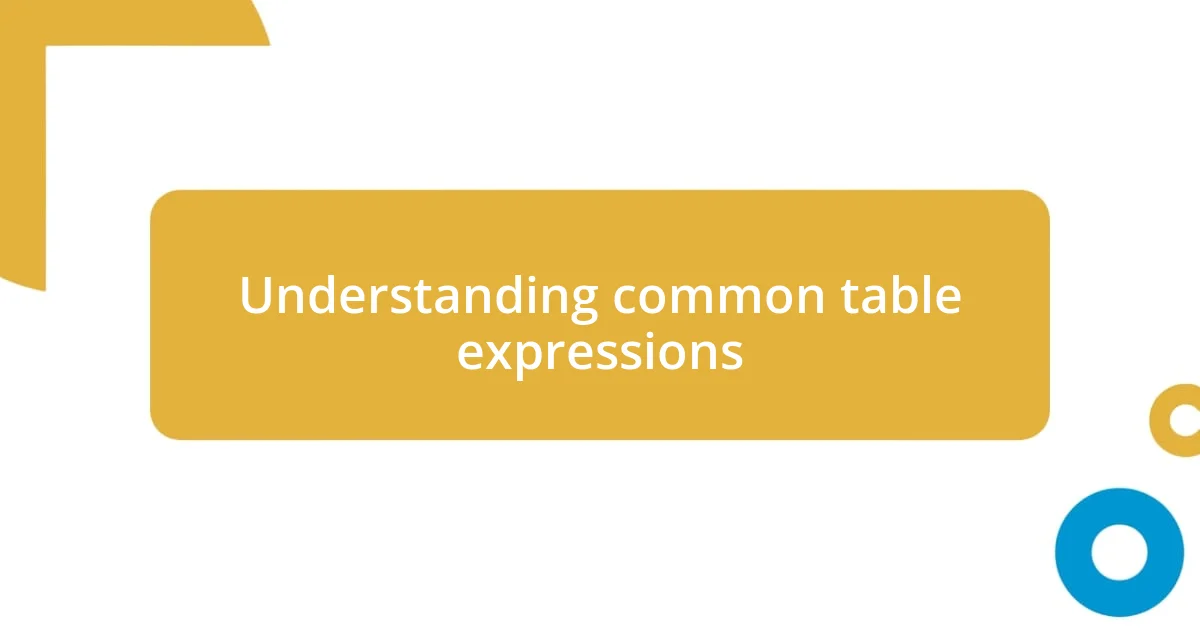
Understanding common table expressions
Common table expressions (CTEs) are essentially named temporary result sets that I find invaluable for organizing complex queries. When I first started using them, it felt like I had discovered a hidden gem within SQL. CTEs help structure my code in a way that’s easier to read and maintain, which really eases my workflow, especially when working with intricate datasets.
With CTEs, I often find myself reflecting on the “WITH” clause that precedes them. It acts like a roadmap, guiding me through the logic of my queries. Have you ever grappled with a convoluted SQL statement only to find that a simple CTE could have clarified the whole process? I experienced this firsthand when a particularly messy query turned remarkably straightforward after introducing a CTE, allowing me to focus on the insights rather than the complexity.
One of the most appealing aspects of CTEs for me is their recursive capability; I can create hierarchies that mirror real-world relationships. This feature has transformed the way I approach certain problems. I recall a project where I needed to analyze a company’s organizational structure—using a recursive CTE made it not only feasible, but also surprisingly enlightening. Isn’t it fascinating how a tool designed for simplicity can unlock such complex analytical possibilities?
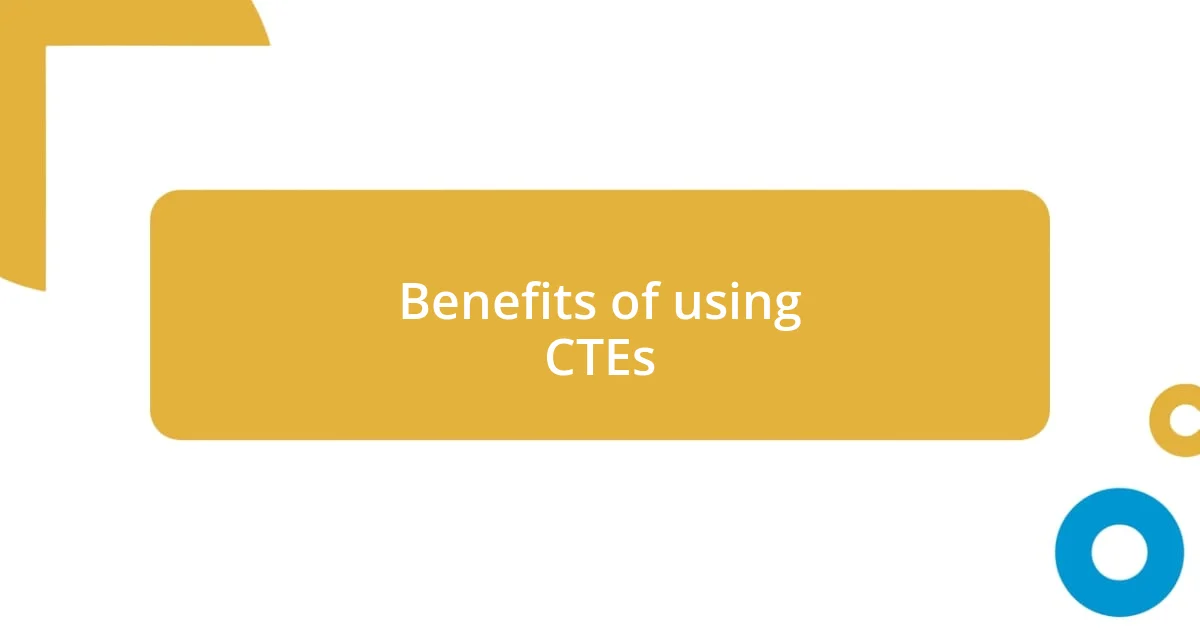
Benefits of using CTEs
The benefits of using common table expressions (CTEs) are profound and transformative. For me, one of the standout advantages is the clarity they bring to my SQL code. When I’m deep in a complex query, CTEs allow me to break it down into manageable sections. I remember a situation where my code was approaching the complexity of a tangled ball of yarn. By applying a few CTEs, the entire structure became streamlined, and I could visualize the flow of data effortlessly. It’s like having a clear path in a dense forest; everything becomes so much easier to navigate.
Here are some key benefits I’ve experienced with CTEs:
– Improved Readability: CTEs make it straightforward to understand the logic behind a query.
– Reusability: Once defined, the result set can be referenced multiple times, saving me a lot of repetition.
– Structured Workflow: I can tackle each part of a query in isolation, which reduces errors.
– Recursive Queries: This feature allows me to explore hierarchies in my data, which is a game-changer for complex datasets.
– Debugging Made Easier: Isolating components with CTEs makes it simpler to pinpoint issues in my queries without sifting through a wall of code.
Each of these benefits contributes to a more enjoyable coding experience and ultimately better results. It’s amazing how these temporary result sets can turn what often feels like an uphill battle into a more manageable and even enjoyable task.
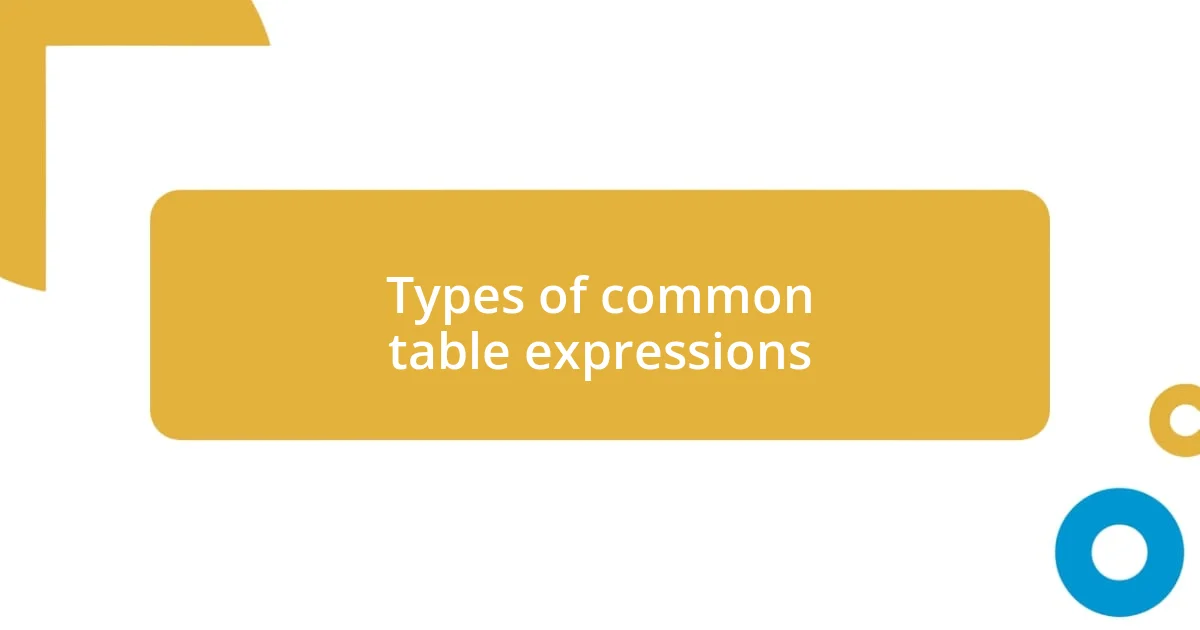
Types of common table expressions
When diving into common table expressions (CTEs), it’s essential to recognize that they come in two primary types: non-recursive and recursive. Non-recursive CTEs are my go-to for straightforward data grouping and filtering. For instance, I recall a time when I needed to create a summary report of sales data; using a non-recursive CTE allowed me to aggregate figures easily while maintaining clarity in my query. In contrast, recursive CTEs have a unique charm; they enable me to traverse hierarchical data, revealing relationships I might have otherwise missed. I recently used a recursive CTE to illustrate a tree structure of product categories, and the depth of insights was truly revealing.
The distinction between these CTE types is more than technical; it’s about conversation—between me and the data. When I utilize non-recursive CTEs, it feels like laying down the foundation of a conversation, ensuring that I have clear and distinct points to address. On the flip side, recursive CTEs bring a sense of exploration, allowing me to discover hidden layers in my datasets. Isn’t it intriguing how these structures not only facilitate data retrieval but also foster a deeper understanding of the relationships within it?
Here’s a quick comparison of these two CTE types to help clarify their differences:
| Type | Description |
|---|---|
| Non-Recursive CTE | Used for straightforward queries, grouping, and filtering data without self-references. |
| Recursive CTE | Enables designation of hierarchies in data, allowing for self-referencing calls to analyze complex relationships. |
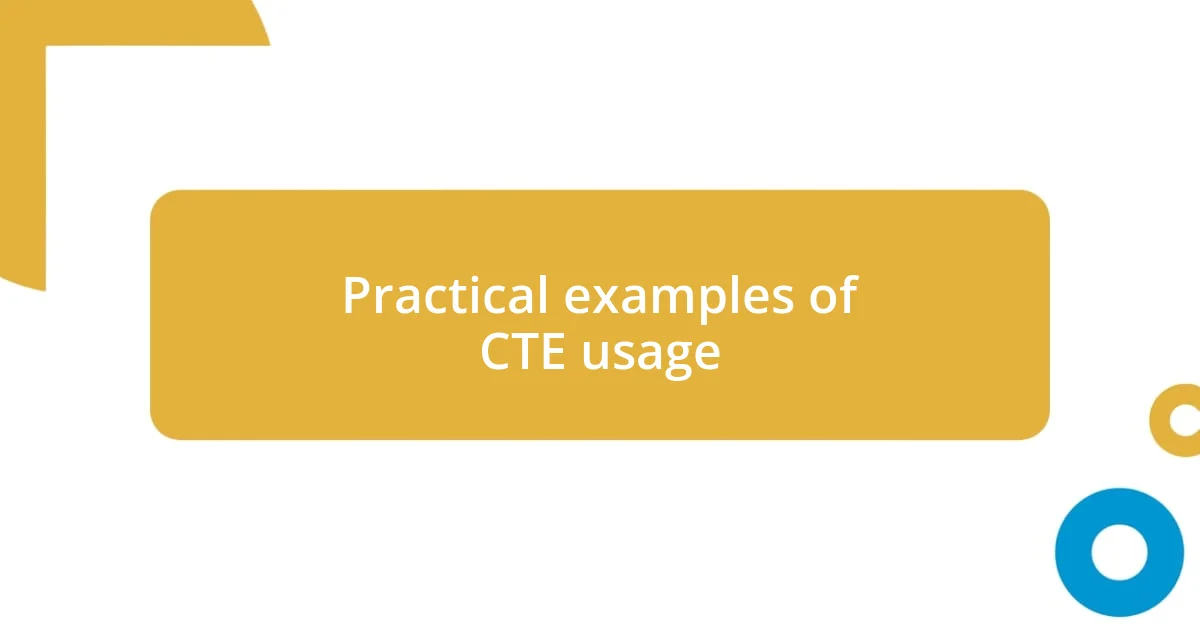
Practical examples of CTE usage
When I think about using CTEs, I often recall a project where I needed to analyze trends over several years in customer data. By employing a non-recursive CTE to summarize monthly sales figures, I found that not only was my SQL query more efficient, but I could also present findings to my team with confidence. It’s as if the CTE transformed my raw data into a clear narrative, making it easier to communicate insights effectively.
On another occasion, I faced a daunting task: extracting data from multiple interconnected tables to represent a multi-level organizational chart. This is where recursive CTEs showed their true value. After setting one up, I could visualize hierarchies effortlessly, illuminating relationships that initially felt obscured. Isn’t it rewarding when a tool not only solves a problem but reveals new insights in the process?
I’ve also utilized CTEs for simplifying complex joins. Recently, when tasked with merging data from various sources, I created multiple CTEs to break down the joins into manageable pieces. This layered approach allowed me to identify exactly where things were going awry; getting to the root of a query’s issue felt almost like detective work! Have you had that moment of clarity while coding? Those moments are what keep me excited about data analysis.
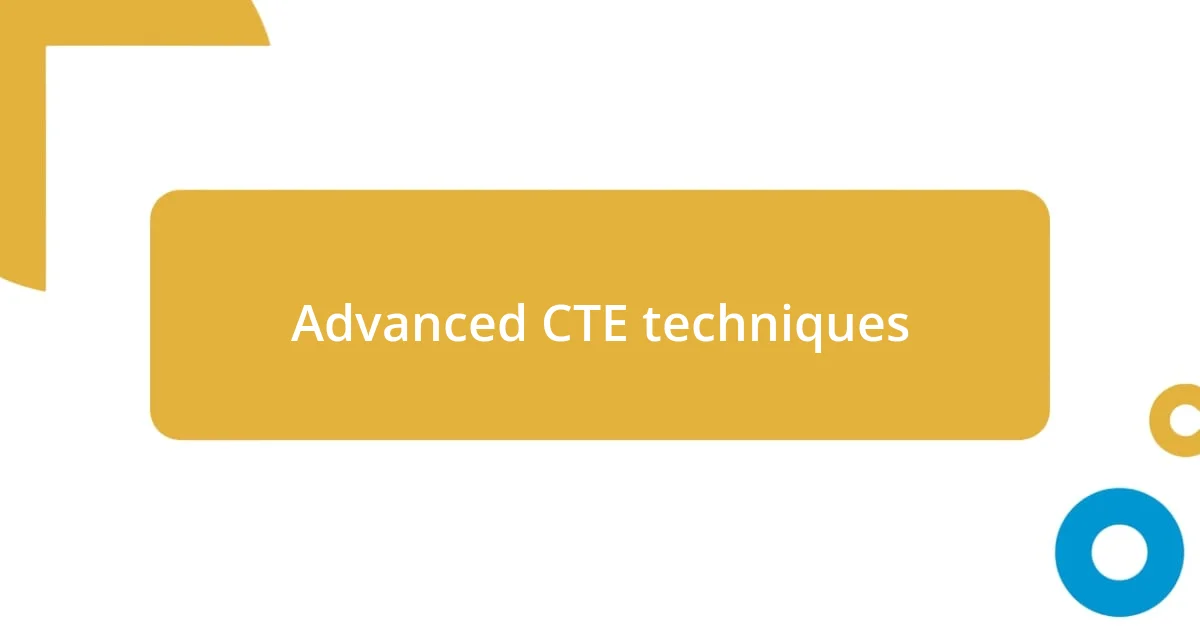
Advanced CTE techniques
When diving into advanced CTE techniques, one method I’ve found invaluable is the use of multiple CTEs within a single SQL statement. I remember a situation where I had to analyze customer purchase patterns across different regions. By segmenting my data into several CTEs, each focusing on specific aspects like demographics and sales figures, I crafted a multifaceted view that highlighted trends I hadn’t noticed before. Isn’t it amazing how breaking data down can lead to such rich insights?
A more nuanced technique I often explore is the use of window functions alongside CTEs. This powerful combination allows me to calculate aggregations, like running totals or moving averages, with a level of flexibility that’s hard to beat. For instance, when I was tasked with assessing sales performance over time, leveraging both a CTE and window functions let me compute monthly averages alongside actual sales figures effortlessly. It felt like turning a complex puzzle into a clear image—everything just clicked into place!
Lastly, parameterizing CTEs is another advanced technique I’ve grown fond of. With parameters, I can pass dynamic values to CTEs, making my queries more adaptable to changing requirements. I once implemented this for a reporting tool that needed to filter by various criteria based on user input. The sheer joy of presenting a solution that not only worked but elevated user experience was truly rewarding. Have you ever experienced that satisfaction when your code perfectly aligns with users’ needs? It reinforces my belief in the importance of adaptability in data analysis.
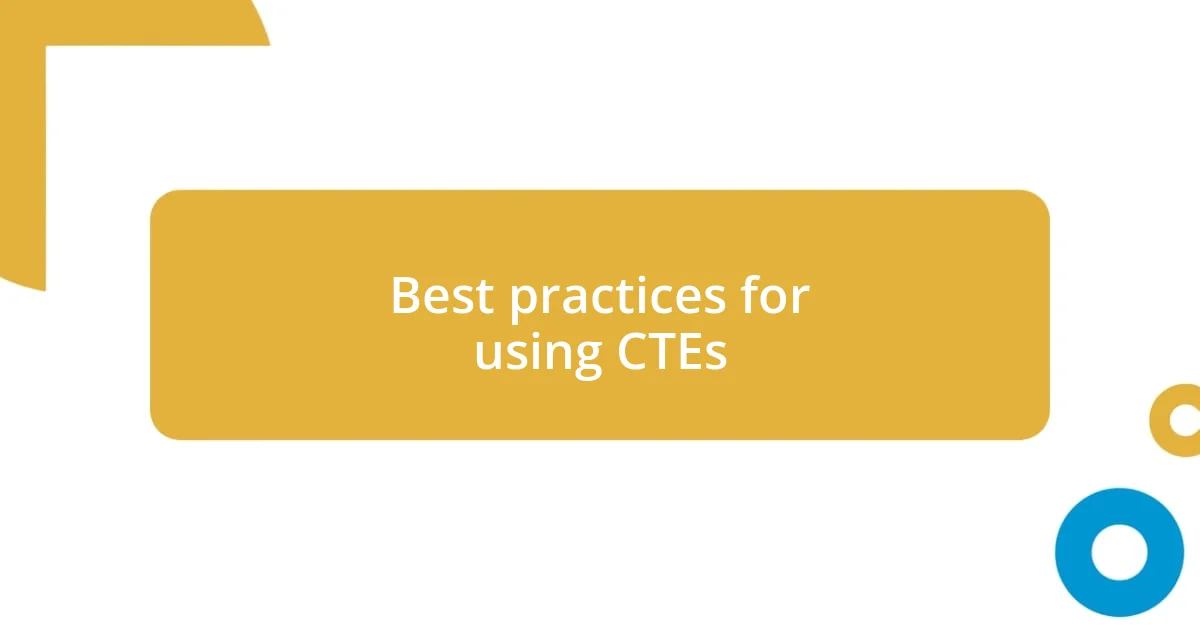
Best practices for using CTEs
When it comes to best practices for using CTEs, clarity is key. I remember a project where I packed too much into a single CTE. My query became confusing, and it took ages to troubleshoot! I learned the hard way that breaking down complex logic into smaller, more focused CTEs not only makes the code more readable but also simplifies debugging. Have you ever found clarity in simplicity? That experience taught me the value of straightforward design.
Another crucial practice is to utilize meaningful names for your CTEs. I recall a time when a colleague named a CTE “temp” in a major reporting query; it baffled everyone who read it later. Effective naming enhances understanding instantly, creating a self-documenting code that speaks for itself. Isn’t it satisfying when a name conveys exactly what the CTE is doing? It’s those little details that can elevate an entire project.
Lastly, I can’t emphasize enough the importance of limiting the scope of CTEs. I’ve made the mistake of referencing unnecessary rows or columns that only complicated the logic. It’s like packing a suitcase that’s way too heavy because I didn’t consider what I truly needed. By maintaining focus and including only relevant data, I can optimize performance significantly. How often do we overlook the simplicity of being selective?














